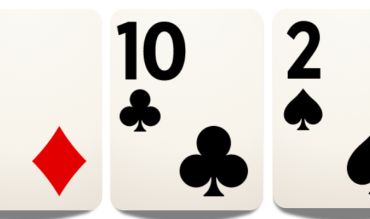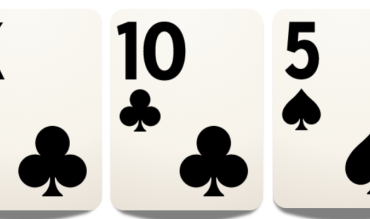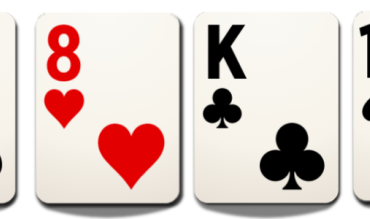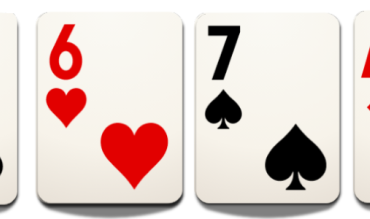Updated on January 25, 2025
One of the strategy nuances in poker is understanding the different types of draws, which can significantly impact how you approach some decisions at the table.
One of those is the inside straight draw, a scenario that requires careful consideration of poker odds, position and opponents' tendencies.
Let's break it down.
Explanation of Inside Straight Draw
An inside straight draw, also known as a “gutshot”, is a straight draw where the card required to complete our straight appears in the middle of the structure.
For example, we hold 7♥️6♥️ on a 9♦️T♣️2♠️ flop and need the Eight to complete our straight.
We are relying on one specific card, falling inside the sequence, which is generally unlikely.

Inside straight draws have less value than “open-ended straight draws’. An open-ended straight draw is where the cards required to complete our straight appear on the outer edges of our structure.
For example, when the straight draw is 6-7-8-9. In this instance, any Ten or Five would complete our straight.
So, we are twice as likely to complete an open-ended straight draw as opposed to an inside straight draw or gutshot.
Example of 'Inside Straight Draw' used in a sentence -> I called the preflop 3bet and flopped an inside straight draw.
Inside Straight Draw Poker Scenarios
To make it easier for you to understand what a poker inside straight draw is, let's explore a few Texas Hold'em scenarios to show how they play out:
Inside Straight Draw on the Flop:
- Hand: A♦️J♦️
- Board: K♣️T♣️5♠️
In the above scenario, you'd have an inside straight draw because only the Queen (which falls in the middle of the sequence) would complete the straight.

Four Queens remain in the deck, giving you four outs to improve your hand.
Inside Straight Draw on the Turn
- Hand: 6♠️9♠️
- Board: 5♠️8♥️K♣️T♠️
In this situation, any 7 would complete a straight. So, again, you'd have four outs to improve your hand.

Inside Straight Draw on a Paired Board
- Hand: T♣️9♣️
- Board: 6♣️6♥️7♠️A♦️
Despite the paired board, you still have an inside straight draw and need an 8 to complete a straight.

But this situation calls for cautiousness.
Even though a straight would still be a strong hand, a full house or quads could beat it.
Inside Straight Draw Poker Strategy
Even though the specific strategy for playing inside straight draws depends on the exact poker variant we are playing, here are some general strategic principles:
H3: Always consider the cost of calling compared to the potential reward.
- If you're on the flop, you have a 16.5% chance of completing your inside straight draw by the river.
- On the turn, there's an 8.5% chance of completing it on the river.
- While a good gutshot should rarely fold the flop, it frequently has to give up on the turn if it is not getting the right price.
Is our inside straight draw to the nuts?
- Inside straight draws to the nuts are always stronger. Non-nut inside straight draws run the risk of being dominated when they complete.
- You have to be especially careful when a board is very coordinated, like 4♥️5♥️7♠️.
- The chance of someone else having a better straight may increase, so it's essential to know if you're drawing to the nut straight.
- A dry board such as 2♣️6♠️T♦️ is much safer, so your draw (87) might be worth chasing.

Inside straight draws (or gutshots) often make good hands for semi-bluffing. So, they are great candidates for aggressive play, especially if their outs are to the nuts.
However, facing aggression with gutshots is tougher since they don’t hit very often.
Poker Inside Straight Draw – FAQ
What is the difference between an inside straight draw and a gutshot?
There is no difference. An inside straight draw is simply another name for a gutshot. However, gutshot is far more common than inside straight draw. An inside straight draw has four outs and differs from the open-ended straight draw, which has eight outs and can be completed by a card on both ends of the sequence.
How do I know if I have an inside straight draw?
You have an inside straight draw when you need one specific card in the middle of five consecutive cards to complete a straight.
How often does an inside straight draw hit in poker?
- From flop to turn or turn to river in Hold’em, an inside straight draw will hit around 8.5% of the time or one in 11.8 times. It hits slightly more often from turn to river because there is now one less card in the deck that is not an out.
- From the flop to river, an inside straight draw will hit around 16.5% of the time or one in 6.1 times.
In Omaha, how strong is an inside straight draw?
Inside straight draws not accompanied by other types of draws or made hands in Omaha Poker are often very weak, even if they are drawing to the nuts.
See Also
Originally published on November 28, 2018


